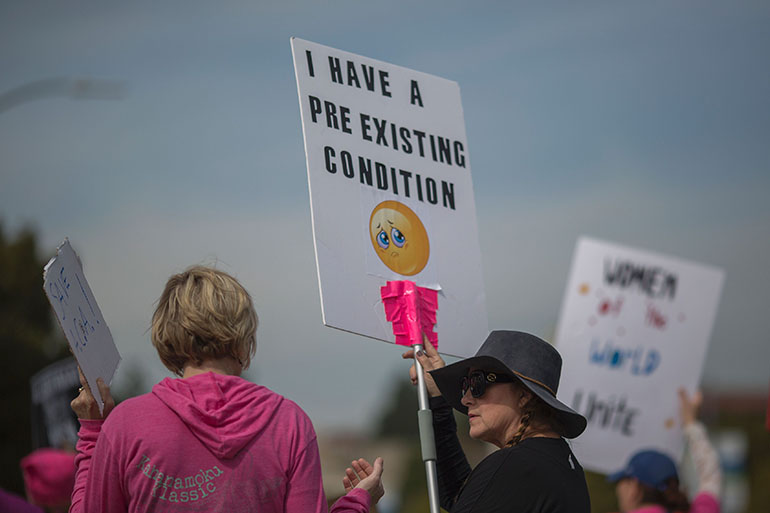Before he was diagnosed with head and neck cancer in 2015, Anthony Kinsey often went without health insurance. He is a contract lawyer working for staffing agencies on short-term projects in the Washington, D.C., area, and sometimes the 90-day waiting period for coverage through a staffing agency proved longer than the duration of his project, if coverage was offered at all.
When Kinsey, now 57, learned he had cancer, he was able to sign up for a plan with a $629 monthly premium because the agency he was working for offered group coverage that became effective almost immediately. The plan covered the $62,000 surgery to cut out the diseased bone and tissue on the left side of his face, as well as chemotherapy and radiation. His share of the treatment cost was $1,800.
If the American Health Care Act, which the House recently passed, becomes law, people like Kinsey who have health problems might not fare so well trying to buy insurance after a lapse.
 Insuring Your Health
Insuring Your HealthThe Republican bill would still require insurers to offer coverage to everyone, including people who have preexisting medical conditions, such as diabetes, asthma or even cancer. But it would allow states to opt out of the federal health law’s prohibition against charging sick people more than healthy ones. In those states, if people have a break in coverage of more than 63 days, insurers could charge them any price for coverage for approximately a year, effectively putting coverage out of reach for many sick people, analysts say. After a year, they would be charged a regular rate again.
Coming up with a figure for how many people have preexisting conditions that could put them at risk for facing unaffordable health insurance premiums has been the subject of debate, with estimates ranging from 133 million on the high end to 2 million on the low end.
What we know is that before the Affordable Care Act, known as Obamacare, insurers in the individual market frequently charged people more if they were sick. According to a 2009 survey of individual market insurers by America’s Health Insurance Plans, a trade group, 34 percent of coverage was offered at higher-than-standard rates, while 6 percent of those offers included waivers that excluded coverage for specific conditions.
But some health policy analysts suggest that it’s not only people who have a gap in coverage who could be affected if a state seeks the health law waiver. There could be consequences for anyone with a preexisting condition, even those who have maintained continuous insurance coverage. That’s because the bill opens the door for insurers to set rates for people based on their health. For example, those without a health condition could be offered discounted premiums.
“If you have a preexisting condition, you’re going to be put into the block of business with the sicker risk pool,” said Sabrina Corlette, a research professor at Georgetown University’s Center on Health Insurance Reforms.
Requiring people to maintain continuous coverage is the Republicans’ preferred alternative to Obamacare’s individual mandate that requires people to have insurance or pay a fine. But there are many reasons people may have a gap in coverage, especially if they’re sick, say consumer advocates.
“If they’re diagnosed with cancer and going through a grueling treatment, they might move closer to their caregiver or the cancer center,” said Kirsten Sloan, vice president for policy at the American Cancer Society Cancer Action Network. “They may quit their job for that reason, or they may lose their job.”
Once people have a gap in coverage they may really be in a bind if the available coverage is unaffordable. To address this, the Republican bill requires states to set up a high-risk pool or reinsurance program or participate in a federal risk-sharing program.
State high-risk pools, which were available in 35 states before the ACA passed, have been widely criticized, however, as inadequate for people with expensive health care needs. Premiums were often extremely high, and there were frequently lifetime or annual limits on coverage. Some plans excluded coverage for as long as a year for the very conditions people needed insurance.
Still, Thomas Miller, a resident fellow at the American Enterprise Institute, says high-risk pools offer a reasonable solution for the 2 million to 4 million people in the individual market he estimates have preexisting conditions but would otherwise be medically uninsurable or offered such high-cost coverage that they couldn’t afford it. The $130 billion over nine years that the bill sets aside to use for high-risk pools or other individual market activities, along with an additional $8 billion over five years for states that get waivers from ACA community-rating requirements, “could be adequate” to meet the need, he said.
Besides, he argued, the higher rates would last for only a year.
“Once you’ve paid up, you graduate back to the regular market,” Miller said. “It’s not like being sentenced to the Gulag.”
Kinsey said he plans to keep his coverage up to date from now on, but he doesn’t think it’s fair to charge sick people higher rates even if they have a break in coverage.
“It would be problematic,” he said. “I’m not in favor of that.”
Please visit kffhealthnews.org/columnists to send comments or ideas for future topics for the Insuring Your Health column.







